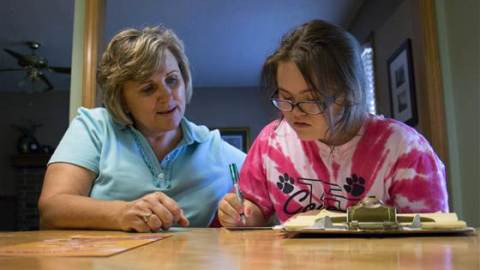World News – Most parents that have a child with down syndrome say that they could not love that child more than they already do……but what if there was the ability to stop down syndome? Would you play God and make sure your child did not have a chance of having this condition?
 In the 14 years since her daughter, Rachel, was born with Down syndrome, Jawanda Mast has always been clear that she’d change the condition if she could.
In the 14 years since her daughter, Rachel, was born with Down syndrome, Jawanda Mast has always been clear that she’d change the condition if she could.
“I couldn’t love her more, but I would give almost anything to take away that extra chromosome,” the Olathe, Kansas, mom wrote on her blog. “While I may know she’s perfect, the world doesn’t.”
But when Massachusetts scientists announced recently that they’ve found a way to silence the chromosome that causes trisomy 21, also known as Down syndrome, it rocked Mast – and the rest of the disability community.
“It’s so hard to imagine you could actually do that,” Mast told NBC News. “Yes, I would take away the challenges, I would take away the health risks. But now I also stop and say, ‘Oh my goodness, how would that impact the rest of her?’”
Hailed as a “cure in a Petri dish,” the research by scientists at the University of Massachusetts Medical School is the first to find that it may be possible to switch off the genetic material responsible for the condition that causes cognitive delays, heart defects and shortened lifespans.
The development is expected to help create new treatments for problems caused by Down syndrome — but it also raises the prospect of eliminating the condition entirely.
Since it became public last month, the breakthrough has sparked a firestorm of reaction among parents, advocates, ethicists and people with the condition, said Dr. Brian Skotko, a medical geneticist and co-director of the Down Syndrome Program at Massachusetts General Hospital.
“This research really launches a million questions,” Skotko said.
On one hand, almost everyone agrees there’s a need for treatments to help the 250,000 people in the U.S. living with Down syndrome, including the nearly 7,000 babies born with it each year.
On the other hand, it’s unclear what costs there may be to shutting down the mechanism that creates people who offer lessons in patience, kindness — and what it means to be human.
“If Down syndrome were completely cured, the world would lose something from the absence of that culture,” said Skotko, who has a sister with the condition. “There is something positive that people with Down syndrome contribute to the world.”
Brian Long of Boulder, Colo., is the father a 19-year-old son with Down syndrome. He welcomes the research, which could lead to treatments to boost Connor’s intellectual abilities and speaking skills and prevent disease. But he also wonders how tinkering with chromosomes could alter the essence of his son.
“So much of Down syndrome does impact the personality and character of the person,” said Long, 54. “In Connor’s example, we’ve known him for 19 years. We don’t want a wholesale change.”
Advocates like Julie Cevallos, vice president of marketing for the National Down Syndrome Society, emphasize that the research is still early.
“When you go as far as a ‘cure,’ that’s when folks step back and go: ‘We’re not looking for a cure. We’re looking  to help and support people with Down syndrome live healthy and productive lives,’” said Cevallos, mother of a 5-year-old with the condition.
to help and support people with Down syndrome live healthy and productive lives,’” said Cevallos, mother of a 5-year-old with the condition.
David Egan, a 35-year-old Vienna, Va., man with Down syndrome, said he applauds the progress in part because it might help with some of the social stigma that comes with the disorder. He has friends who’ve been made fun of because of their disability, who have a hard time coping with the condition.
“I’m not saying to shut it down completely,” said Egan, who has worked for 17 years in the distribution department at Booz Allen Hamilton, the technology consulting firm. “I would say just to understand more about it.”
But ethicists fear that genetic manipulation could spell the end of the disorder – and of people who have it.
“We now see very few persons with the symptoms of polio or the scars of smallpox,” said Art Caplan, head of medical ethics at New York University Langone Medical Center. “The same fate, despite the protests of some, awaits Down syndrome and other genetic diseases if engineering genes creates cures.”
That strong reaction surprised Jeanne Lawrence, the professor of cell and developmental biology who led the research. People may misunderstand the scope and promise of her work, she said.
It likely wouldn’t be possible to “cure” Down syndrome, because the condition occurs at conception, she said.
“Even looking forward really far, I don’t see how we could fundamentally change a person who has trisomy 21 to silence all the chromosomes in their body,” said Lawrence.
Instead, it might be possible to target specific conditions: Perhaps there will be a way to treat congenital heart disease early in children with Down syndrome or to stave off Alzheimer’s disease in adults, she added.
No question, the research is an advance in the understanding of Down syndrome, which occurs when people are born with three copies of chromosome 21, instead of the normal two copies.
(Humans are typically born with 23 pairs of chromosomes, including one pair of sex chromosomes, for a total of 46 in each cell. People with Down syndrome have 47 chromosomes in each cell.)
The researchers discovered that a gene called XIST — which normally turns off one of the two copies of the X chromosome in female mammals, including humans — could be inserted into the extra copy of chromosome 21 in lab cultures.
Using skin cells from a person with Down syndrome, they created pluripotent stem cells, which can form a range of different body cell types. When they inserted the XIST gene, they found that it effectively silenced the extra chromosome.
When they compared brain cells with and without the XIST gene, they found that those in which the extra chromosome had been suppressed grew more quickly and were better able to form progenitors of other brain cells, Lawrence said.
“That’s kind of useful right away,” she told NBC News. “There hasn’t been a good way to understand what’s wrong with these cells.”
But her work was never targeted to eliminate the condition, Lawrence added.
“I guess that we always thought that we were developing therapies to help children with Down syndrome. We never thought for a moment we would aid in the eradication of it,” Lawrence said.
That’s a relief to geneticists like Skotko. He worries about the demographics of the disorder, which has been altered from an estimate of 400,000 people with Down syndrome in the U.S. to 250,000, according to new research by Dr. Edward R.B. McCabe, chief medical officer at the March of Dimes.
The number of babies born with Down syndrome has been rising in the past decade, McCabe found. But research suggests that about 74 percent of women who receive a prenatal diagnosis of Down syndrome end their pregnancies. And — in a country where women are delaying childbirth — there are not nearly as many Down syndrome births as there could have been.
“What if fewer babies with Down syndrome are being born and Down syndrome starts to inch closer to being a rare condition?” said Skotko.
The promise of new drug therapies and treatments may help, he says, giving hope to families expecting Down syndrome babies and to those with older children – and adults.
Still, Jawanda Mast says she’s certain the questions raised by the new research will be debated for years in public meetings and in private conversations.
“It’s an interesting thing because Rachel’s whole life, there’s been this discussion: ‘If you could take it away, would you?’” she said. “I think, ethically, we’re just taking the cap off the bottle.”
JoNel Aleccia is a senior health reporter with NBC News. Edited by Dan Stevens
Pictures from Chuck France / Getty Images for NBC News

